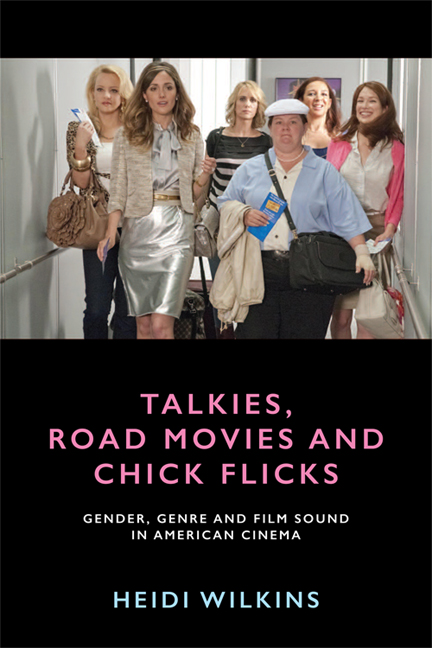Book contents
- Frontmatter
- Contents
- Acknowledgements
- Introduction
- 1 Talking Back: Voice in Screwball Comedy
- 2 All That Jazz: The Diegetic Soundtrack in Melodrama
- 3 The Alienated Male: Silence and the Soundtrack in New Hollywood
- 4 Brothers in Arms: Masculinity and the Vietnam War Movie
- 5 Subversive Sound: Gender, Technology and the Science Fiction Blockbuster
- 6 Girl Talk: The Postmodern Female Voice in Chick Flicks
- Conclusion
- Bibliography
- Filmography and Other Sources
- Index
6 - Girl Talk: The Postmodern Female Voice in Chick Flicks
Published online by Cambridge University Press: 05 August 2016
- Frontmatter
- Contents
- Acknowledgements
- Introduction
- 1 Talking Back: Voice in Screwball Comedy
- 2 All That Jazz: The Diegetic Soundtrack in Melodrama
- 3 The Alienated Male: Silence and the Soundtrack in New Hollywood
- 4 Brothers in Arms: Masculinity and the Vietnam War Movie
- 5 Subversive Sound: Gender, Technology and the Science Fiction Blockbuster
- 6 Girl Talk: The Postmodern Female Voice in Chick Flicks
- Conclusion
- Bibliography
- Filmography and Other Sources
- Index
Summary
The image on the front cover of this book is from the 2011 film Bridesmaids and depicts the film's female characters embarking on a bachelorette party. This type of exclusive, female-only event or rite of passage frequently features in postmodern ‘chick flicks’ and in this final chapter, I revisit my discussion of the female voice in mainstream cinema to explore the aural representation of women in contemporary chick flicks. In examining this category of films, it is clear that they have some evolutionary links with the screwball comedy genre discussed in Chapter 1. This is evident in the female characters we encounter in modern chick flicks who, like their screwball predecessors, are often strong, confident and quick-witted, engaging in verbal battles to achieve their ‘happily ever after’ either with their lead male character or with fellow female characters, or sometimes with both.
Films that have come to be defined as chick flicks tend to be, according to Suzanna Ferriss and Mallory Young, ‘commercial films that appeal to a female audience’. As Ferris and Young explain in their in-depth analysis of contemporary women at the movies, chick flicks frequently span numerous genres including romantic comedy, melodrama, thriller or the female friendship movie. However, the narratives, themes and ideology from which they have evolved make chick flicks more than just simply movies for women and not for men, as I will demonstrate in this chapter. These films frequently portray a complex representation of modern females and female chick flick protagonists are often hard-working, intelligent, professional women and working mothers. In line with postfeminist notions of having the freedom to choose, and unlike previous second wave agendas that rejected femininity, women in postfeminist chick flicks revel in the pleasures of womanliness, embrace consumerism, thrive on the notion of ‘having it all’ and do not hold back when it comes to verbalising their experiences of contemporary womanhood.
Angela McRobbie has posited that postfeminism can be explored as a ‘double-entanglement’ between the co-existence in society of neo-conservative values related to gender, sexuality and family life and the process of liberalisation in regard to choice or diversity in domestic and sexual relationships.
- Type
- Chapter
- Information
- Talkies, Road Movies and Chick FlicksGender, Genre and Film Sound in American Cinema, pp. 149 - 185Publisher: Edinburgh University PressPrint publication year: 2016



